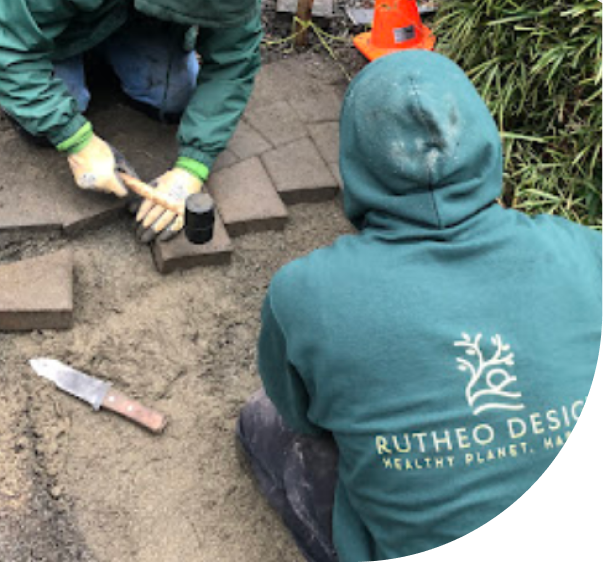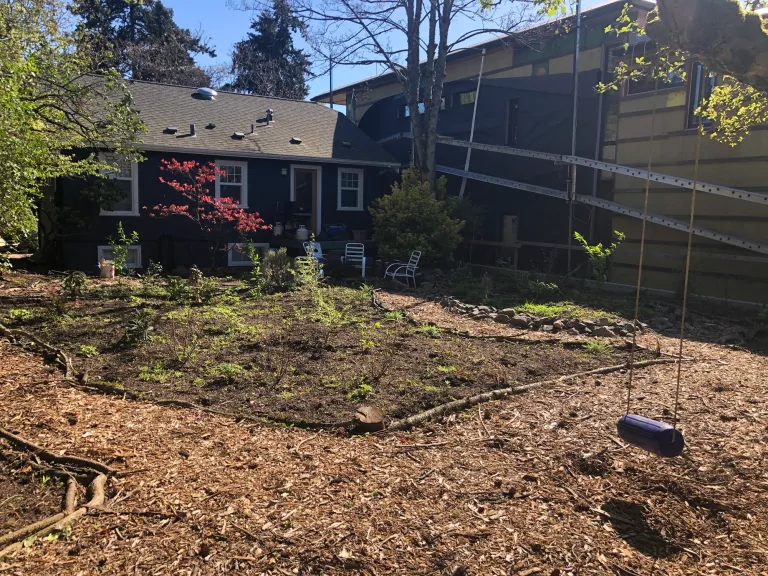
At Rutheo Designs, we believe that pollinator gardens are more than just vibrant, colorful landscapes—they are vital ecosystems that support biodiversity and promote environmental health. In Seattle, where urban development can fragment natural habitats, creating pollinator-friendly spaces helps sustain native bees, butterflies, hummingbirds, and other essential species. Our approach to pollinator garden design focuses on integrating native plants that provide continuous nectar and pollen sources throughout the seasons. By carefully selecting species like red-flowering currant, yarrow, and Oregon grape, we create dynamic gardens that not only attract pollinators but also thrive in Seattle’s unique climate. We prioritize plant diversity, layered habitats, and natural features like water sources and nesting sites to foster a balanced ecosystem right in your backyard.
Designing effective pollinator gardens begins with understanding the basic needs of pollinators: food, water, and shelter. Nectar- and pollen-producing plants provide essential food sources, while shallow water features, such as birdbaths with stones for landing, offer hydration. Natural nesting sites, including bare soil patches for ground-nesting bees and hollow stems for solitary bees, are crucial for supporting pollinator life cycles. Overwintering habitats, like leaf litter and dead wood, provide shelter during colder months.
A successful pollinator garden offers resources throughout the year. Incorporating a variety of plants with staggered bloom times ensures a continuous food supply from early spring to late fall. Evergreen species and dense plantings provide winter habitats, while larval host plants support the development of butterfly and moth caterpillars. This layered approach creates a robust ecosystem that supports pollinators at every stage of their life cycles.
Resilience and sustainability are central to pollinator garden design. Selecting native plants adapted to Seattle’s climate reduces the need for supplemental watering and minimizes maintenance. Drought-tolerant species thrive during dry summers, while plants suited to wet conditions can help manage seasonal rainfall. Incorporating permaculture principles, such as polyculture planting and soil-building techniques, further enhances the garden’s sustainability and ecological function.
Native plants are the cornerstone of effective pollinator gardens. Wildflowers like Oregon sunshine, camas, and yarrow attract a variety of bees and butterflies. Shrubs such as red-flowering currant, vine maple, and serviceberry provide nectar, pollen, and habitat for birds and insects. The use of regionally adapted plant species supports local pollinators and fosters a sense of place within the landscape.
Diversity in plant selection is key to attracting a wide range of pollinators. Tubular, daisy-like, and clustered flowers cater to different bee species, while specific host plants support butterfly larvae. Brightly colored, tubular-shaped flowers like penstemon and columbine are particularly attractive to hummingbirds. By including plants with varied flower shapes, colors, and bloom times, gardens can support a broad spectrum of pollinators.
Companion planting enhances pollinator activity and garden health. Combining plants with complementary growth habits and ecological functions can improve pollination rates and deter pests naturally. Herbs such as lavender, thyme, and basil not only attract beneficial insects but also support pest management. A diverse plant palette creates a balanced ecosystem where beneficial interactions among plants and pollinators flourish.
Creating vertical diversity within the garden provides multiple habitat layers, from ground covers to tall canopy trees. This structure supports different species by offering varied microclimates, nesting sites, and food sources. Mass plantings of the same species can attract pollinators more effectively than isolated plants, while structural elements like shrubs and tall perennials create windbreaks that protect delicate insects.
Hardscape features can be integrated thoughtfully to support pollinator habitats. Bee hotels, logs, and brush piles provide nesting sites, while water features like shallow ponds and mud puddles offer hydration and mineral resources. Permeable pathways reduce soil compaction, allowing ground-nesting bees to establish their homes undisturbed.
Adapting pollinator garden designs to Seattle’s unique climate and topography ensures long-term success. Rainfall patterns, soil types, and drainage conditions influence plant selection and placement. Maximizing sun exposure promotes flowering and pollinator activity, while careful management of slopes and stormwater helps preserve habitat integrity. By considering these site-specific factors, gardens can thrive in harmony with the local environment.

At Rutheo Designs, we are dedicated to transforming your outdoor spaces into beautiful, sustainable landscapes that reflect your vision and the unique character of the Seattle area. We offer services in native plant landscaping, water-efficient irrigation, custom landscape design, and hardscaping solutions tailored to your goals and the local environment. Every project is unique, and we take the time to listen to your needs and offer personalized solutions that align with both your aspirations and Seattle’s natural surroundings.
We invite you to reach out to us to start the conversation about your landscaping needs. You can contact us by email at connect@rutheodesigns.com or give us a call at (360) 844-2989. Whether you have specific questions or are ready to schedule a consultation, we’re eager to help you bring your outdoor vision to life with the care and expertise that Rutheo Designs is known for.